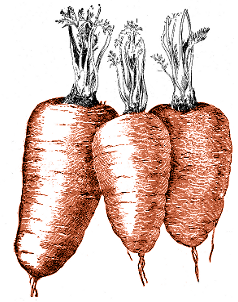Archive for the ‘Practicalities’ category
Posted in Decorative, Practicalities on Thursday, January 19th 2012 (6.08 PM).
As I mentioned our seed tin in passing the other day, I thought I might tell you a bit more about it. I asked for it on my Christmas list last year, and it comes from Ripe, a little independent homeware supplier that used to have a shop on Perry Road, but now operate from a mail-order address in Totterdown. It is, technically, a lunch tin, with cartoon hedgehogs on the side.
The Mother phoned up, after getting the list. “This tin. You do realise it’s a child’s lunch tin?” Well, yes. “You could use any old tin to keep seeds in!” I’m not sure she really understood that just having a tin wasn’t entirely the point.
seed, storage
Posted in Garden Diary, Photobloggery, Practicalities, The Old Garden In Bristol on Monday, January 2nd 2012 (11.09 PM).
The intention, over the long Yuletide break, was to finish off tidying up the garden, clean out those remaining pots which had last year’s perennials in, and get straight on with finishing the digging of the back bed. The reality, however, was that the sofa and fireside proved too attractive.
Despite that, I have started to use one of the garden-related presents I received. From K’s sister: a garden-themed notebook.
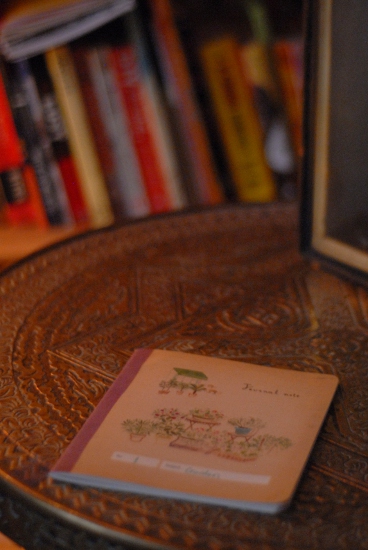
It came from Papermash, ultimately from a Korean stationery company, and inside is a normal ruled notebook; but I do love the watercolour cover. I’m going to use it as a garden diary notebook, so that I can write down what I’ve noticed when I notice it, and what I’ve done when I’ve done it, without having to come online and come here to make a note. So far it has but one entry, from last Wednesday, when I noticed the first garlic plant poking its shoot up above the surface of the soil. So far there is still only one shoot visible: I must have planted that clove rather shallower than the rest.
diary, garlic, notebook, record, recording, winter, yuletide
Posted in Photobloggery, Practicalities, The Old Garden In Bristol on Sunday, December 11th 2011 (3.10 PM).
We missed harvesting the last green beans and runner beans this year, because we had a holiday planned. By the time we got home, they had gone past eating. Still, no point letting them go to waste, so we left the beans on the plant to develop and dry. That was the intention, at least: as the weather became wetter, it didn’t look like there was much chance of them drying successfully on the plant, so we picked them and popped them into a tub in the fridge – unsealed, but covered with kitchen roll. I gathered it would be a good drying-out spot for beans: cold, dark, and naturally drying. Now, a few weeks later, they are dry, hard, and ready to be popped into a storage tin. And they are beautiful: creamy-white green beans and rich, midnight blue and pink runner beans.
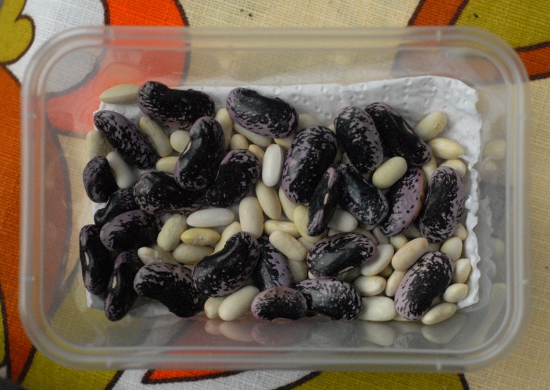
It is, really, the whole point of sustainable gardening. We are never going to be self-sufficient, with our little city plot, but equally we don’t want to be restocking our containers with freshly-grown garden centre seedlings each spring when we can raise our own instead. I don’t expect all of these seeds to be viable, but we don’t need many to be viable: this pot could fill our entire garden with beans if we wanted. This isn’t sophisticated breeding: the runner beans are from some spare plants a friend gave us, and the green beans are from some free seeds the BBC was giving out the other year, part of their Dig In project. Being beans, they might not even breed true, but hopefully next year’s bean supply is now in place.
bean, green bean, runner bean, saving seed, seed
Posted in Planning, Practicalities, The Old Garden In Bristol on Sunday, December 4th 2011 (10.12 PM).
In the news the other day: the ongoing drought is, well, ongoing; it will take an awful lot of rain just to get our aquifiers back to where they normally are by the end of winter.
Over in Bristol things aren’t as bad as they are further east: we have more rainfall over here than the rest of the country, or at least it always feels that way. Still, it makes me feel guilty about container gardening. It does need more water: containers are always drying out, and don’t catch as much rain as you might expect, especially in a sheltered garden with walls and fences on all sides. Our back bed, when we get it into use, will assuredly be always slightly too damp: it already tends to have a green scum quickly appearing on the surface of the soil, as if it were still in the Proterozoic eon.
What we should be doing, of course, is getting a butt set up. Indeed, if you scroll down or look back at the layout of our garden, you’ll see that we have a couple of potential butt-sites mapped out. One, by the door, would take up quite a bit of our main container-planting space. The other, in a corner between the shed and the house, would be a useful way to occupy an awkward spot; but the problem is getting the water to it. The former site is right by the downpipe, but the more useful site is a long way from the water supply. A pipe would have to be run across the back of the house – right across where the kitchen window is. The gutters are too low, really, to run a pipe across the top of the window, and a pipe underneath it would mean a rather short water butt.
The whole thing is a bit of a tricky problem. I know, conscientiously, we should be saving at least a portion of our rainwater, but finding the place to save it in is going to be a problem. Maybe we’re going to have to think of another way to do it, and work out a more radical answer.
butt, climate, rain, rainwater, water, water butt, weather
Posted in Garden Diary, Photobloggery, Practicalities, The Old Garden In Bristol on Sunday, November 27th 2011 (8.22 PM).
Today, we cut down the remaining wizened bean plants, having made sure we had saved all the potentially viable beans for sowing next spring. With the beans and their canes missing, the garden has lost all its height, and looks very empty all of a sudden. Very bare, compared to June or July.
However, the cycle goes around. In the post, the other day, a garlic bulb arrived.
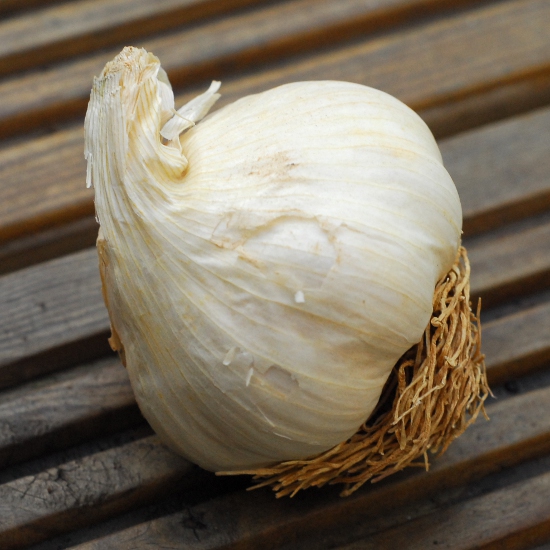
Carefully peeling off the papery skin revealed a tight-packed spiral of fat cloves.
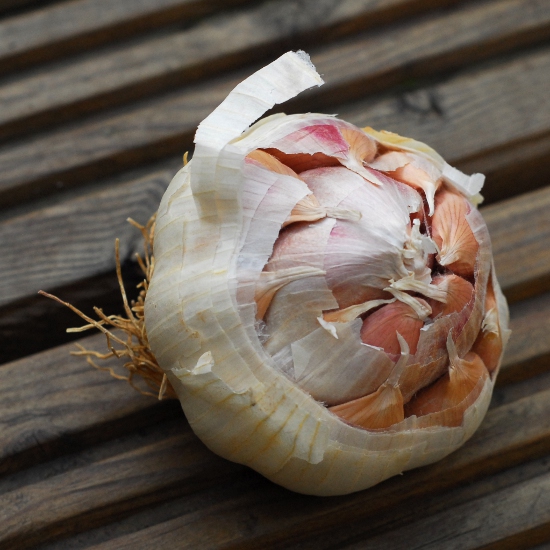
This is a softneck variety, Solent Wight, chosen because it’s meant to be a particularly easy variety to grow in southern England, as you might expect from the name. The cloves were planted up in a couple of our largest containers, moved to the sunniest side of the garden along the wall of the house; in spring a thin sprinkling of annual flower seeds might go in between the garlic stems if there looks to be enough space for them. In 8 or 9 months, if all goes well, this bulb will have turned into ten or more ready for drying and eating.
bean, garlic, green bean, planting, runner bean, solent wight, sowing
Posted in Practicalities, The Old Garden In Bristol on Sunday, October 30th 2011 (8.50 PM).
As I think I mentioned a while ago, shortly after we moved into Symbolic Towers we noticed a vinelike plant spreading itself rapidly over the garden trellis. None there at all when we moved in, but within a couple of months the trellis was covered. Bindweed. It seems to be endemic in this part of Bristol: you can’t go anywhere this time of year without seeing its foliage and its white trumpets clogging up fences and doing their best to strangle other plants, particularly in semi-wild areas like the edges of railway lines. We’ve spent a lot of time tracing every stalk, and digging up every little bit of bindweek rhizome we could find; carefully, like archaeologists, to make sure we didn’t break the rhizomes up or leave fragments behind. It has mostly worked: a few stems have come back, but only a few, none of them very strong. On those, we tried a method we heard on Gardeners’ Question Time: singing and blackening the leaves. It worked, too, sort of, although (of course) not as effectively as physical removal.
I was aware, of course, that things could have been far, far worse. Moreover, I was reminded by a news story K came across, about Japanese knotweed. It reminded me of the advice I read in (I think) an Alys Fowler book: if you have knotweed, move house. There are knotweed-infested places in Bristol – Arno’s Vale cemetery, for one, and some parts of the riverbank in St Philips – and, if we visit any, we are always extremely careful not to go near the stuff. Over-careful, maybe, but it’s not something we could exactly risk.
bindweed, bristol, japanese knotweed, perennial weed, weed, weeding

